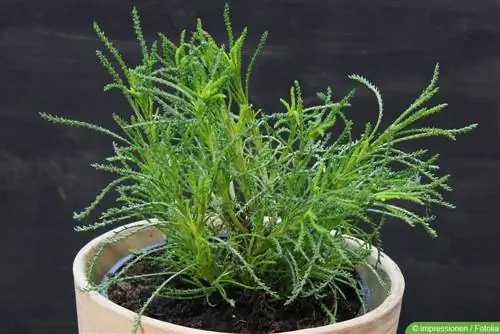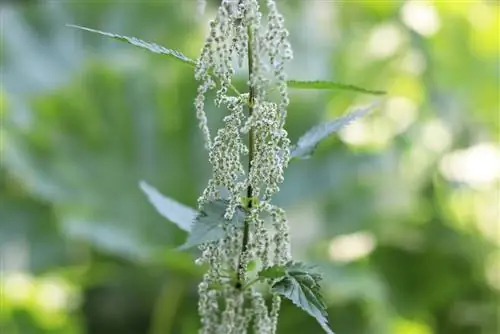- Author admin [email protected].
- Public 2023-12-17 03:39.
- Last modified 2025-01-24 12:45.
Rosehip is the fruit of the rose flower of different types of wild roses, of which there are more than 150 species. This is a non-toxic collective nut fruit. Inside its fleshy shell there are numerous small nuts, the actual seeds of the rose hip. The fruits form around September/October from the white or pink flowers of wild roses, provided the plant has not been cut after flowering. The dog roses Rosa canina are said to have the best aroma.
Location and soil
The rose hips or wild roses that form rose hips can be planted in an airy, sunny or partially shaded location. If you have the choice between a sunny or semi-shady location, you should prefer the sunny one, because the sunnier the plant is, the more profusely it will bloom. 4-6 hours of sun per day are sufficient. They thrive in almost any good garden soil, which can be dry to fresh, slightly calcareous and slightly acidic to slightly alkaline. Soils with a high nitrogen content should be avoided, as should waterlogging and drought, although short-term drought is just tolerated.
Planting rose hips
Bare-rooted plants can be planted in spring or autumn and containers can be planted all year round, provided the soil is frost-free. Before planting wild roses, the planting area should be loosened up, preferably two spades deep, and the root ball should be watered. The planting hole should be large enough for the root ball to fit comfortably, about 30 x 30 cm. For bare-rooted produce, it is advisable to shorten the roots slightly before planting or before watering. After compost, manure and mineral fertilizer have been added to the planting hole, the plant can be inserted, filled with excavated soil and piled up with soil. Finally, water thoroughly.
Tip:
After planting, it is advisable to mulch the soil about 10 cm thick, which significantly minimizes weed growth. Removing wild growth afterwards is difficult due to the numerous spines.
Watering and fertilizing
- In the right location, the rose hip hardly needs any care.
- You only water enough so that the soil neither dries out completely nor is waterlogged.
- Even in winter, the soil must not dry out completely.
- Accordingly, watering is minimal on frost-free days.
- Regular fertilization is not necessary.
- It makes sense to add fertilizer when planting.
- You work compost, mineral fertilizer and manure into the soil.
- Add some compost in spring and autumn from the second year onwards.
Cutting
Native wild roses bloom on biennial wood. Even if regular pruning is not necessary, it makes sense. A so-called planting cut is made during planting. The shoots are cut back to just a few buds. Otherwise, only remove dead and damaged wood in spring or autumn. After about 5-6 years, more severe pruning is recommended. All branches that are older than two years are cut off close to the ground. Branches that are too long or too sprawling can be shortened by a quarter or half. This promotes the formation of new shoots and rejuvenates the rose bush in question.
Tip:
All cuts should be made at an angle so that water can drain off easily and does not collect on the young shoots. Sufficiently sharp cutting tools can avoid bruising.
Sowing
For sowing, you can remove the seeds from ripe rose hips and remove the pulp. They then have to undergo heat/cold treatment (stratification). To do this, place them in a plastic bag with moist sand, close it and store it at room temperature for 2-3 months. Then the whole thing goes into the fridge for 4 weeks. After cold treatment, seeds are sown in commercially available potting soil and the substrate is moistened. It takes several months for germination.
Tip:
To separate germinable seeds from non-germinable ones, place them in a container with room temperature water for about 24 hours. The seeds floating at the top are not capable of germinating, only those lying on the bottom are able to germinate.
Cuttings or cuttings
Propagation from cuttings or cuttings is much more promising. Cuttings are cut in summer from almost mature shoots and should have 5-6 eyes. Cuttings are cut from woody shoots in late autumn before the first severe frosts. They should be between 20 and 30 cm long. Remove half of the leaves from cuttings, place them in potting soil with 2-3 eyes and put a transparent film over them. For cuttings, the lowest leaves are removed. They are encased in moist sand until spring, kept cool and frost-free over the winter and only then put in loose soil in the garden so that the top eye sticks out of the ground.
foothills
For this form of propagation, the desired number of runners is cut off from the mother plant with a spade in spring or autumn. Then they are shortened by about a third and each of these runners that has sufficient roots is planted in its final location.
Harvesting
- The fully ripe rose hips can be harvested around autumn.
- Fruits should be fully colored and still firm.
- Harvest in sunny and dry weather, then the active ingredient content is highest.
- After the first frost, the rose hips become soft.
- But they can still be harvested and further processed now.
- Stems and flower heads are removed.
- Then cut the fruit lengthwise.
- Then remove the seeds, including the fine hairs.
- These could cause irritation in the mouth and throat.
- Afterwards, rinse the shells and seeds thoroughly and, if necessary, chop the shells.
- Don't throw away the seeds, they can be used to make tasty seed tea.
Tip:
The fruits of apple rose and dog rose ripen at about the same time, while those of potato rose ripen gradually and have to be harvested several times.
Drying and storage
Use a standard dehydrator or an oven to dry. The fruits should not lie on top of each other when drying, but should always be spread out in a layer so that air can circulate well between them. Drying is probably easiest in a dehydrator. In the oven, spread the fruit loosely on a baking tray lined with baking paper. Then you put the tray in the preheated oven on the middle rack and initially set it to 75 degrees. The fruits are turned over every now and then and the oven is set to 40 degrees after about an hour.
The oven door should remain slightly open throughout to allow moisture to escape. For this you can e.g. B. jam a wooden spoon into the door. Once the drying process is complete, the oven door is opened and the fruit is allowed to cool completely. Once the rose hips have completely dried and cooled down, they are ideally stored in air-permeable containers, e.g. B. in small cotton bags so that any residual moisture can still escape and the fruit does not start to mold. They will now last for several months.
Tip:
During the drying process in the oven, the drying status should be checked again and again and the drying time should be shortened or extended accordingly. The pulp must be completely dry.
Conclusion
The rose hip is obtained almost exclusively from wild roses. In addition to the dog rose (Rosa canina), the most common wild roses that bear rose hips include the apple rose (Rosa villosa), the potato rose (Rosa rugosa), the wine rose (Rosa rubiginisa), the mountain rose (Rosa pendulina) and the Pillnitz vitamin rose. All of these roses are very undemanding when it comes to location and care. They produce extremely he althy fruits that are also very decorative and a popular source of food for local birds in winter.






